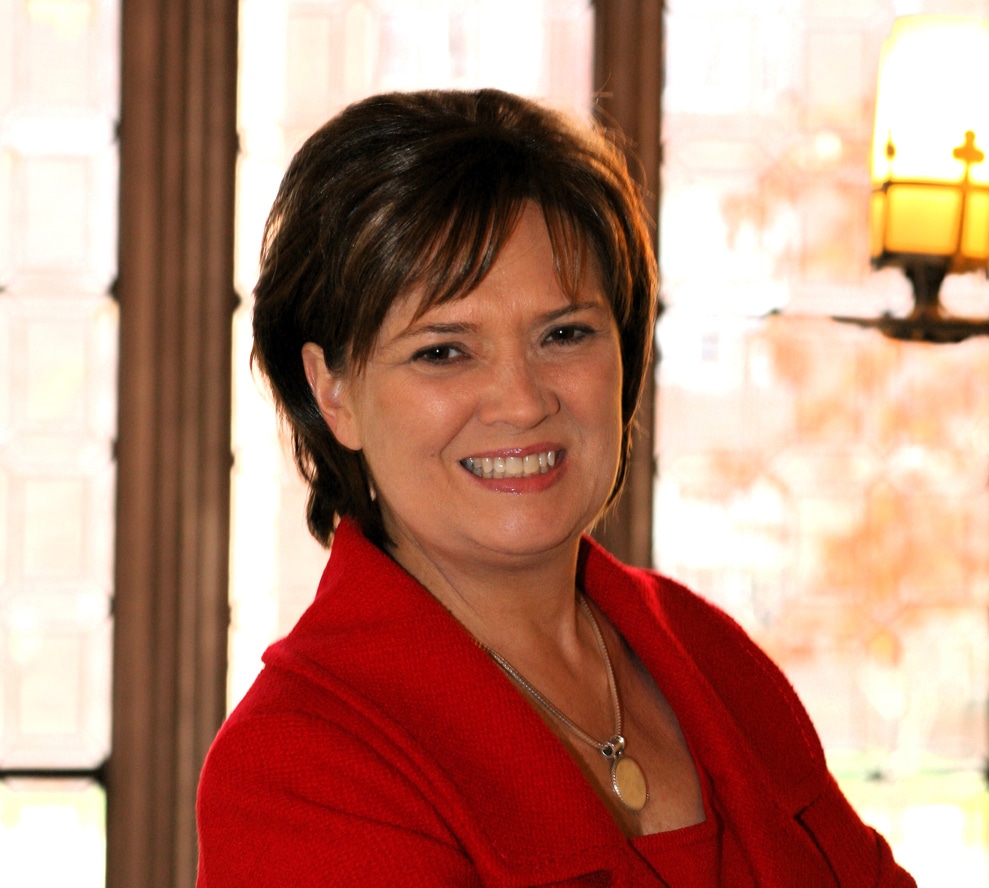Lynn Pasquerella has served as the president of the American Association of Colleges & Universities (AAC&U) since July 2016. We are honored that she will give the keynote address at the 2019 Interfolio Summit, a unique three-day event featuring educational sessions, interactive workshops, and networking opportunities for the academic institutions that use Interfolio to manage faculty hiring, data, and professional reviews.
As an educator and former college president, what inspires you in your role as the President of AAC&U? What do you find most exciting and rewarding?
I am inspired every day by working with colleagues across the country and around the world who are committed to AAC&U’s mission of advancing the vitality and public standing of liberal education and equity as the foundations for excellence in undergraduate education in service to democracy. Despite a prevailing national rhetoric that calls into question the value of higher education, in general, and liberal education, in particular, colleges and universities continue to represent powerful institutional forces in catalyzing individual and societal transformation.
What I find most exciting and rewarding is the opportunity to work with the extraordinarily talented staff at AAC&U in taking up a collective call to action to reaffirm the role that a liberal education plays in discerning the truth; the ways in which it serves as a catalyst for interrogating the sources of narratives, including history, evidence and facts; the ways in which a liberal education promotes an understanding that the world is a collection of interdependent yet inequitable systems; the ways in which it expands knowledge of human interactions, privilege and stratification; and the ways in which higher education fosters equity and justice, locally and globally.
In an era where more and more is being asked of faculty, in terms of teaching, service, and research, what do you think the biggest challenges are for the academe today?
The most significant challenge facing higher education today is a growing economic segregation. Community colleges and other state institutions enroll more than three-quarters of all students, and yet public education is becoming increasingly privatized. Student aid has failed to keep pace with rising tuition, and the fact that publics have had to do more with less has led to more contingent faculty, larger classes and widening gaps between publics and privates in spending per student. It is no coincidence that the shift away from the notion of higher education as a public good toward viewing it as a private commodity coincided with opening the gates to women, first-generation college students, students of color and the poor. College completion rates for those at the lowest socioeconomic rungs continue to lag far behind those of their wealthier peers.
Until we change the reward systems within the academy, structural impediments will continue to marginalize the critical work of those dedicated to providing the broadest access to higher education through humanistic practice and promoting student success through high impact practices. And yet at present, we go so far as to discourage pre-tenured faculty from focusing too much on teaching and service. Activities engaging actual, questioning human beings, whether in the classroom or in the community, drop out of professional focus. Academic institutions should actively reconsider pathways to recruitment, tenure and promotion, placing scholarship into reasonable balance with humanistic modes of activity in the classroom and beyond–not by eliminating scholarship, but by broadening what we value as an expression of that mastery.
How has the higher education landscape changed since you first became President of AAC&U in 2016?
We are living in an ostensibly post-truth era, characterized by the denial of authoritative knowledge and the disdain of experts, and in which rational inquiry built on evidence has all but been abandoned. Arising from an entire industry designed to sway public opinion, a rhetoric-for-hire has emerged in which the art of persuasion has been replaced by incivility and misinformation, giving rise to widespread anti-intellectualism. In this arena, asserted claims become orthodoxy regardless of the absence of evidence and in the face of enduring questions. This trend signals the extent to which the marketplace of ideas is at risk of falling prey to those who have the resources to control the shaping of public opinion and policies.
A false-crisis narrative has been fueled by politicians who have gone so far as to advocate for their state workforce needs by proposing legislation that would base funding for public colleges and universities exclusively on job acquisition for college graduates or stripping out so-called frills, such as “the search for truth,” “public service,” and “improving the human condition” from their university system’s mission statements. A liberal arts education, they would have us believe, is reserved for those within the ivory tower, reflecting a willful disconnect from the practical matters of everyday life. This positioning magnifies the image of a liberal education as a self-indulgent luxury—an image that has led to the excising of humanities programs, especially in public institutions, in favor of vocational and pre-professional programs that are regarded as singularly responding to demands for economic opportunity. Talk of higher education as a public good and of investing in society through education has been replaced by talk of a return on investment—tuition in exchange for jobs. The narrow focus on earning power undoubtedly makes it is easier for state legislatures and taxpayers to justify defunding higher education. This has coincided with a push toward the unbundling of higher education and proposals to outsource the entirety of a student’s education to companies that can deliver fast-track certificates to meet employers’ demands.
How have technology and innovation played a role in those shifts?
There is no doubt that advancements in technology and innovation have resulted in a focus on STEM in training the workforce of the future. Yet, with rapidly changing technology becomes rapid obsolescence. More than ever, we need to integrate the arts, humanities and STEM. This conviction is supported by the National Academies’ report, Branches from the Same Tree. The report found the need to “achieve more effective forms of capacity building for twenty-first century workers and citizens,” through the acquisition of broad-based skills from across all disciplines “that can be flexibly deployed in different work environments across a lifetime.” It concludes that “In a world where science and technology are major drivers of social change, historical, ethical, aesthetic, and cultural competencies are more critical than ever. At the same time, the complex and often technical nature of contemporary issues in democratic governance demands that well-educated citizens have an appreciation of the nature of technical knowledge and of its historical, cultural, and political roles in American democracy” (54). For, “truly robust knowledge depends on the capacity to recognize the critical limitations of particular ways of knowing,” and “to achieve the social relations appropriate to an inclusive and democratic society” (54).
You followed an inspiring and somewhat non-traditional pathway through higher education to the presidency, and now leader of AAC&U, beginning your career as a community college student working 35 hours a week at a factory in your hometown while caring for your chronically-ill mother. But your experience also mirrors the realities of most college students, with independent, part-time and working students making up a larger and larger share of higher education today. How can faculty members learn from, and better support, these students?
We need to engage in pedagogical practices that enable us to view students through a new lens—one that offers a more complete picture. If we are to help students to see their world beyond their own front doors; to find their passions; to align the people they are with the people they hope to be, we must make strides toward an equity-minded approach to higher education, which requires that we reject, once and for all, a “deficit perspective” that focuses on what students are missing, and instead adopt an “asset perspective,” offering evidence-based interventions and high impact practices through the targeting of cognitive, non-cognitive and psycho-social factors for all students.
We know that such practices have a disparately positive impact on women, students of color and first-generation students, and yet, as my colleague Tia McNair points out in our publication A Vision for Equity, while many institutions are disaggregating data on retention and graduation rates of students from traditionally underserved groups, “far fewer are disaggregating data on students’ participation in high-impact educational practices or on their achievement of educational learning outcomes”. Questions about equity in student outcomes must be a core component of student-success initiatives if we are to fulfill the public purpose of higher education.
Has your previous experience working on the frontlines as an academic leader shaped your viewpoint of the national higher education scene?
Absolutely. Today’s college presidents are called upon to serve as multidimensional CEOs of complex organizations. Presidents must communicate compelling messages about the value-added of attending their institutions to political leaders and an increasingly skeptical public concerned about the costs of higher education, student debt burdens and the employability of graduates. This task is made more difficult by scandals involving admissions, like the recent Operation Varsity Blues, high-profile sexual assault and harassment cases, and violations of NCAA rules and regulations. In addition, they must negotiate among different constituencies—board members seeking rapid change to secure a strong financial future, faculty who are suspicious of the corporatization of higher education, and alumni who are concerned about safeguarding the reputation of the institution and the worth of their credentials. At a time when political polarization on college campuses is greater than it has been in more than half a century, and a single tweet, blog or Instagram post could lead to a campus crisis that reaches the press before it ever lands on the president’s desk. Having had the experience of being a college president makes it easier for me to understand the complexities of accomplishing sustainable institutional change in support of AAC&U’s mission of promoting liberal education and equity in undergraduate education and to identify ways to break down barriers toward achieving our shared objectives.
What excites you about the future of higher education today?
The students I meet want to make a difference in the world. They don’t just want to get a good job, they want to live a good life. Faculty and staff are eager to help them find meaning and purpose in life. Despite the growing demands, there is an overwhelming commitment by faculty and staff at all types of institutions to provide a deeper-level understanding across subject areas, connecting knowledge to experience, and adopting a holistic approach to evidence-based problem solving that incorporates diverse, sometimes contradictory points of view, as a means of preparing students to thrive in work, citizenship and life.

